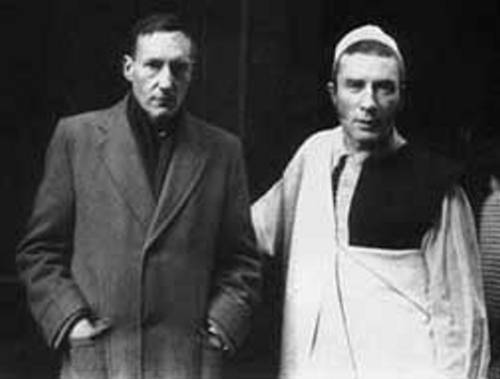
APRIL 2007
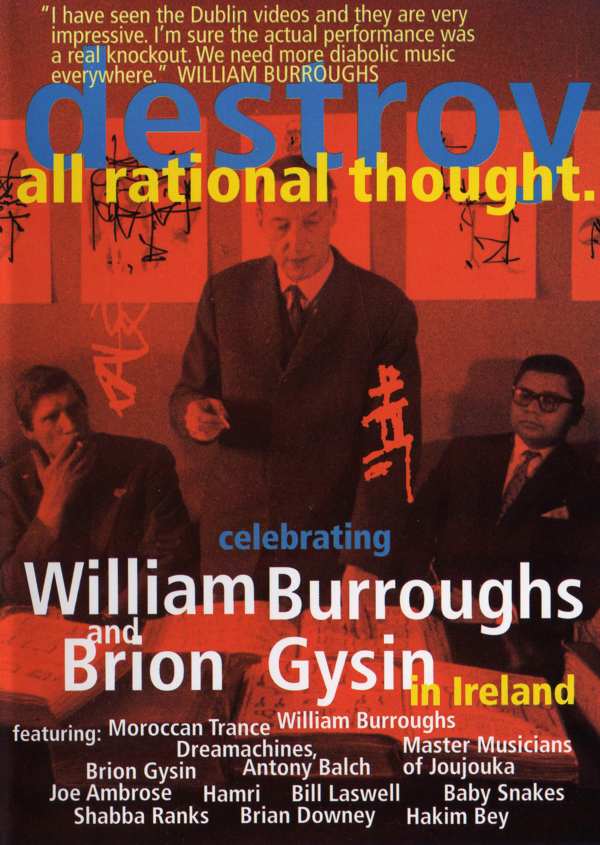
Destroy All Rational Thought - Joe Ambrose and Frank Rynne, an Interview with paul h.
Writer,
musician and art-terrorist Joe Ambrose has seen a lot of
the counter cultural world in his time. He and fellow
musician, cultural historian and writer Frank Rynne
organised the Here To Go Show, put on in and around
Dublin in the early nineties. The film, Destroy All
Rational Thought, which documents many aspects of the
Here To Go Show, is a both a celebratory observance and
an affirmation of the cultural impact and significance of
the work of Brion Gysin and William Burroughs; both
individually and collaboratively. Their favoured
location, in Tangier, determines the Show`s wider subject
spectrum. Lassoed under the happenings they, and other
Beat writers, nurtured, the Tangier Beat Scene cannot be
divorced from the Here To Go Show.
It
has now been woven into an exceptional DVD, containing
performances from the extraordinary to the sublime,
including such influential Beat scenesters as William
Burroughs, Brion Gysin, Hamri (the Moroccan national
painter) and the Master Musicians of Joujouka, amongst
many, many others connected to the Gysin/Burrough`s
Tangier Beat Axis. The DVD contains one of the last
interviews given by William Burroughs as well as
previously unseen footage of him from the 50`s and 60`s,
a slide show of paintings exhibited by Gysin and
Burroughs, the music of Bill Laswell, Frank`s band the
Baby Snakes, Islamic Diggers as well as texts and
contributions by key writers Terry Wilson, Ira Cohen and
Gysin and Burroughs.
Joe
and Frank themselves contribute under various guises and
ongoing guerilla conditions. Usual rules apply.
I
caught up with Joe and Frank to talk about the Destroy
All Rational Thought DVD, the Here To Go Show and to
understand more about the cultural significance of the
Tangier scene and its conspirators.
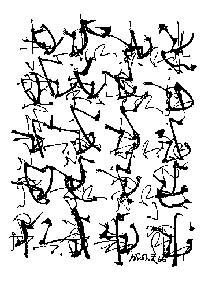 The painting of Brion Gysin deals directly with the magical roots of art. . . . His paintings can be called space art. Time is seen spatially, that is, as series of images or fragments of images past, present, and future. . . . Here is a Gysin scene from Marrakesh, moving figures, phantom bicycles, cars . . . this is a literal representation of what actually happens in the human nervous system; a street reminds you of a car that went by yesterday, or a boy on a bicycle years ago, in fact everything that you have experienced on that street and other streets associated with it. The pictures constantly change because you are drawn into time travel on a network of associations. Brion Gysin paints from the viewpoint of timeless space.
|
***********************
Paul
H: This DVD has just been released, could you tell me
what spurred you to put this show on in Dublin in `92 ?
Frank
Rynne: It was possibly fortuitous circumstances and being
in the right place at the right time...
PH:
What was happening then ?
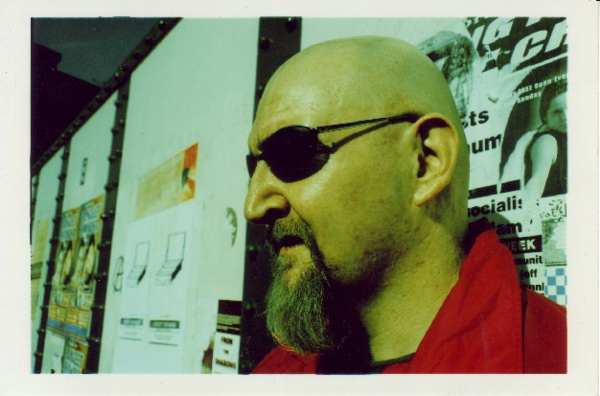
Joe Ambrose courtesy of Maki Kita
Joe
Ambrose: I was squatting in Brixton, London, from 1986
onwards. I was managing Frank’s punk band the Baby
Snakes. That time is partially chronicled in my first
novel Serious Time. By early ’92 the
band had some very recent highs and lows. They’d
recruited a drummer called Nigel Preston – a
founding member of The Cult, played on their big hit
Sanctuary - Nigel brought the long-sought oxygen of
publicity onto the band. I organised a meeting between
the band, myself, and Johnny Cash when it was neither
profitable nor fashionable to be associated with him.
Every second of that meeting was filmed. Then Nigel died
of a drug overdose in the Barrier Block in Brixton and
the walls came tumbling down. Same time I met up with
Terry Wilson, an English experimental writer and
Gysin/Burroughs collaborator. That led directly to the
Here to Go Show.
PH:
What do you remember from those times Frank ?
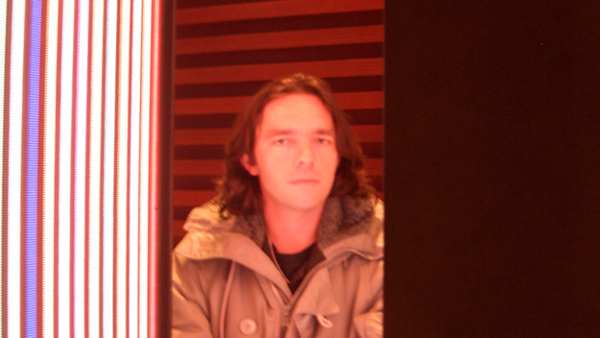
Frank Rynne courtesy of Thierry Poiraud
FR:
From my early teens I’d been a great fan of
Burroughs’ writing and his prophetic vision of the
decay of the West. One of his close friends, Brion Gysin,
had been largely ignored since his death in 1986. There
were many people that knew Brion who felt unhappy about
this; especially his close friends William Burroughs,
Felicity Mason and Terry Wilson.
PH:
There were other faces from that Beat scene on the
Destroy DVD I recognised...
FR:
It also attracted the support of other mavericks like Ira
Cohen, the poet and photographer and Hamri who at the
time was Morocco’s greatest living painter and who
invented the vision of Joujouka music that he and Gysin
promoted. In the end the show did help put Gysin back on
the map. Other people who had seen the energy shown in
Gysin’s work also began promoting his posthumous
reputation, which led to three books, other than Man
from Nowhere : storming the citadels of Enlightenment
with William Burroughs and Brion Gysin , which Joe
Ambrose, Terry Wilson and I did for the show. That and related
published material from the Here to Go Show are now
collectors items and outside the budget of many fans and
interested people.
PH:
So, what did you feel was the purpose of this release on
DVD format ?
JA:
The movie was out on VHS globally through Atavistic in
the States and through John Bentham’s Screenedge
everywhere else. Like everybody else who had videos out,
suddenly there was DVD and endless possibilities arose.
FR:
It was also an opportunity to put in some galleries of
the work that was shown and to republish tributes from
various people that participated in the show.
JA:
Doing a Director’s Interview gave the chance to put
a bit of context onto a rather unconventional film which
had to be filmed guerilla-style, due to ongoing guerilla
conditions.
PH:
What was the magic between Burroughs and Gysin that this
DVD portrays? What was the significance of their work ?
FR:
They toyed with magical ideas such as the “Cut-up
Method” applied to word, sound and film. Their
concept called “The Third Mind”: advocated a
method of artistic collaboration which proposed that
collective ideas produced new concepts that went beyond
the extent of their parts.
JA:
Burroughs was a trail blazer who left his mark on so many
aspects of 20th century culture. Gysin was a close
pal of his at some stage, when they hung out together in
Tangier and at the Beat Hotel in Paris.
FR:
There was also their perverse and deep connection with
the spiritual and political myths surrounding Hassan I
Sabbah, the “Old Man of the Mountain”and leader
of the Hashishin/Assassins of the 11th century. In
Hamri and Joujouka they found the magic of Pan/Boujeloud,
the goat man. In Joujouka they found spirituality
predating the religions of “the book”.

PH:
Yet Gysin wasn’t able to have the same, I dont
know... public persona, cultural clout, that Burroughs
had ?
JA:
I don’t know what the strange fascination that Gysin
exerted over Burroughs was but Gysin spent much of his
life trying to play catch-up on Burroughs’
charismatic trailblazing leadership.
PH:
Although he wasnt completly without admirers, was he ?
JA:
His followers tended to be creepy meatbeaters like
Genesis P. Orridge, Coil, and Ramuntcho Matta. Genesis
allegedly no longer has any meat to beat. By the end of
Gysin’s life in the mid-80s the Burroughs/Gysin
friendship had clearly waned. Burroughs stuck by the
deal, though, and was still doing his best to push Gysin
when the Here to Go Show came around in ‘92. I think
an unstated aim of the Here To Go Show, as far as I was
concerned, and as far as our sponsor Gordon Campbell was
concerned, was to do something about Terry`s status as a
novelist.
FR:
Terry was in touch with Gordon Campbell who was
interested in financing a Gysin related art show. It
began there.
JA:
It’s no joke trying to make it as an obdurate
investigational novelist or even trying to get your work
into print when you do the kind of work that Terry does.
Terry also gave us access to his remarkable archive and
collection of Gysin paintings. As did Felicity Mason, a
formidable old lady who is somewhat forgotten right now
but who deserves to be remembered. She was one tough dame
and I liked her a lot. She was terribly ill at the time
of the Show but she really got involved and was a great
supporter. She said me and Frank were, ‘two charming
Irish terrorists.’
FR:
I think as so much of this work also relates to Morocco
it is worth commenting a little on Paul Bowles' role. He
did give material for the show and recorded interviews
with me and video with Joe Ambrose. Though a great
writer, Bowles was often a destructive force in the
affairs of Moroccan artists. He used his influence to try
and steer people away from people like Choukri and Hamri;
or others who he had fallen out with. Hamri insisted I
visit him in 1994 and I must say he was charming and
incredibly intelligent but a real tricky man too. He
began meddling in the affairs of Joujouka/Jajouka in the
late eighties which was bad for the village. He was a
very dishonest artist yet also a great artist. He did
great damage to many Moroccan people especially male
artists who had moved out of his camp. He was also
surrounded by a bunch of pretty sick American men who
still hang out in Tangier. The sexploitation of Moroccan
children is something that I really revile. Bowles was a
great writer but his malevolence and debauchery informs
that art and must not be ignored if his art is to be
understood.
PH:
Watching and listening to Hamri and The Master Musicians
of Joujouka playing on the DVD, they seemed to conjure up
real spiritual vibe, you guys were there, what was the
atmosphere like ?
JA:
The Musicians have conjured up their own spirit since a
long time ago, probably since the Forties when Hamri
started knocking them into shape up in the mountains.
Then Hamri brought Gysin to hear them and he became a
fan. Hamri brought the Musicians with him to Dublin
because he thought, correctly, that no Gysin party
would’ve been complete without his favourite music.
FR:
The performances were amazing. It was The Master
Musicians of Joujouka’s ethereal spirit and
Hamri’s knowledge and vision of the Joujouka/Jajouka
music, contextualized through his artistic genius, which
so influenced Brion Gysin. Hamri understood the old
Morocco and imparted his knowledge to many in small
amounts and to a few in profusion.
PH: Staying with the Morocan Scene, the sentence
"documentation is everything", to the Tangier
Beat writers philosophy, keeps echoing in my head, what
do you understand by this, their philosophy and the
relevance to the Here To Go Show ?
JA:
I think up until the Beats came along there was more of a
convention wherein, if writers were making work in any
way autobiographical, there was a tendency for them to
portray themselves as superheroes. This is fine or
acceptable because being a creative person is sometimes
just a kiss away from being bipolar but the Beats were
part of what dismantled that self-glorification.
PH:
In what ways did they peel this convention apart?
JA:
Kerouac, Burroughs, and Ginsberg made themselves
available in a very public way.
FR:
Continuous documentation, whether it is released or not
is essential as so much is quickly forgotten by people
involved in this oeuvre.
JA:
Just in the last few months we had this extraordinary
spectacle of seeing Saddam being put to death, seeing
what he looked like as he dropped from the gallows,
seeing him on a gurney with his neck broken, all that
shit. Profoundly watchable and horrible. It seems to me
to belong within the exact same universe as that which,
say, Warhol or Burroughs occupied.
PH:
The Here To Go Show clearly has a wider contextual
panorama, I think you have talked about some of that in
this interview. What further material was produced ?
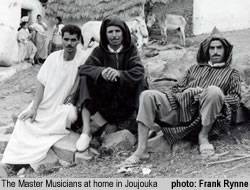 FR:The Here to Go Show led
directly to several projects. The first was The China
White aged 23 Show which featured China White works and
works by Genisis P. Orridge, Hakim Bey, Bruce Ryder and
Joe. In 1994 I travelled to Morocco and began recording
the Master Musicians of Joujouka. This resulted in three
CDs directly, Joujouka Black Eyes (1995), Sufi (1996) and
the most recent release Boujeloud (2006), on the Sub Rosa
label.
FR:The Here to Go Show led
directly to several projects. The first was The China
White aged 23 Show which featured China White works and
works by Genisis P. Orridge, Hakim Bey, Bruce Ryder and
Joe. In 1994 I travelled to Morocco and began recording
the Master Musicians of Joujouka. This resulted in three
CDs directly, Joujouka Black Eyes (1995), Sufi (1996) and
the most recent release Boujeloud (2006), on the Sub Rosa
label.
PH:
So the show led to further artistic and cultural projects
? I think thats important, to build on the themes and
dynamism of the Show, to keep the impact of the Tangier
Beat Scene relevant.
JA:
We’re planning a reissue of the album we produced 10%
File Under Burroughs, for later this year.
FR:
It brought together documents related to the show such as
Burroughs and Gysin sound Cut-ups, Brion Gysin and Terry
Wilson’s Here to Go Tapes, as well as new
contributions from artists like Herbert Hunke, Paul
Bowles, Terry Wilson, Ira Cohen, Scanner, Chuck Prophet,
John Cale, Marianne Faithfull, Stanley Booth, Sufi trance
from The Gnoua Brotherhood of Marrakesh, whom I had
recorded for the Sufi CD, Bomb the Bass, The Master
Musicians of Joujouka and Bill Laswell’s Divination
and Material. It also included further new creative
projects like Islamic Diggers which was Joe and myself
tackling some of the ideas that arose from the Here to Go
Show mixed with Moroccan Trance and our own musical
irreverence. The same year we made the film Joujouka with
Marek Pytel and Chris Campion about Moroccan trance music
that was shot on Super 8 film.
PH:
10% is on the Sub Rosa label, I`m looking forward
to getting a copy, I missed out on its earlier
release....
FR:While
Burroughs was alive he endorsed the work done by myself
and Joe Ambrose and Terry Wilson. He made a special
reference to the performances of the Master Musicians of
Joujouka in his endorsement of Destroy all Rational
Thought; “The actual performances must have
been a real knockout. We need more diabolic music
everywhere”. I think William S. Burroughs sums it up
right there !

William Burroughs, Brion Gysin and Hamri
courtesy of The Sherifya Folklore Association of The
Master Musicians of Joujouka
PH:
Lets just re-establish Burroughs` influence and
significance, as it relates to this scene`s genre and the
Destroy film. Joe, you spoke of him as a trail-blazer in
Part 1, who left his mark on so many aspects of 20th
century culture, can you elaborate on what you meant ?
JA:
Hardboiled fiction, hip hop, literary fiction,
songwriting Lou Reed or Dylan-style, painting very much
so, punk rock in a fundamental way, cyberpunk, comic art,
experimental cinema, style, science fiction… these
are just a few of the areas he touched.
PH:
The autobiographical nature of the Scene`s artists and
writers within their work was a significant step away
from the writer portrayed as superhero, as was the
convention previously. In what ways did this happen?
JA:
Not just in their autobiographical work – and much
of what Kerouac, Burroughs, and Ginsberg did was directly
autobiographical. People like Huncke, Bowles, Ginsberg,
and Burroughs allowed themselves to be interviewed a
great deal, to be photographed and filmed a lot. This is
not necessarily part of the gig involved in being a
writer. Salinger and Pynchon, for instance, are writers
who shared many intellectual interests with the Beats but
who didn’t go along with the cult of the personality
or play the game the way the media wanted them to. Laki
Vazakas did this justly celebrated documentary, Huncke
and Louis, which is an absolutely searing portrayal of
Herbert Huncke during a very difficult time in his life.
Laki kept on filming when somebody came into a room in
the Chelsea Hotel and told Huncke that his long-term
partner, Louis, had just been found dead. You see Huncke
breaking down and crying, quite inconsolable. I found
this awfully hard to look at because I knew and liked
Huncke very much. So did Laki, he was not some
exploitative BBC-style documentary maker but a
sympathetic pal. Laki is one of the good guys. Huncke
never asked him to turn off the camera though he was
being documented at his lowest point. This sort of
chronicling was very much ahead of its time. Documenting
the whole deal – good and bad, warts and all –
is everything.
PH:
You obviously have a great deal of respect for the work
and ethos of the Tangier Beat scenesters, can you tell me
the influence it has had on your work?
FR:
For me it is the production work I have done with Master
Musicians of Joujouka that most closely links me to that
ethos. I learned how to get around in Morocco from Hamri
who imparted similar knowledge to Brion Gysin and William
Burroughs in the fifties and sixties.
PH:
Joe, who would you cite as influences ?
JA:
Hamri, Bowles, and to a lesser extent the writer Mrabet,
are the Tangerinos who`ve influenced me. Since I’m
not a painter it’s more as a man that Hamri has
influenced me. He gave me a thousand stories to tell and
a country to write about. And of course I’ve
part-inherited his thorny crown of Joujouka. Like an old
Joujouka legend, he was a lion pulling a plough. I seem
to be shackled up to that same plough now, like a few
other lions. His life would’ve been so much simpler
without Joujouka. Frank talked about Paul Bowles in Part
1 of this interview and Bowles is the only writer I
aspire towards resembling in any way. It’s a tricky
business writing novels when you’re an intelligent
prodigy like he was but he managed to pull it off. He was
a murderer, a sadist, a voyeur, a poisoner, a polymath, a
sexual exploiter of adolescent boys. He tried to kill
Hamri once. Most entertaining company. Mrabet is the last
surviving member of the Tangier Beat Generation Scene. To
some extent he is a Bowles’ satellite, insofar as
Bowles collaborated with him on all his books but Mrabet
very much has a voice of his own. He is good at putting
the fear of God into dippy white men and I like that.
PH:
How long did the Here To Go Show take to plan and
actually put on ?
FR:
About one year. It was like a production line. In the
last months there was a book in production, Brion
Gysin’s Here to Go Tapes being edited, galleries
being contracted, flights being booked, hotels, visas,
everything was happening at once. I don’t know how
we did it. Terry Wilson was central to the project. I
struck up a conversation with him at a terrible art
opening in Notting Hill in London. Soon myself and Joe
Ambrose were sitting cross-legged on a mattress in his
apartment going through box after box of Burroughs and
Gysin manuscripts, letters and works of art. It seemed
crazy not to do something with this material.
JA:
The Show took its title from a book Terry wrote with
Gysin, Here To Go, which is available on Creation Books
and which anyone interested in countercultural life
should buy and read.
FR:
Terry connected us with various participants. However I
think it was the fact that we were new faces to the scene
that allowed myself and Joe to cut through the petty
squabbles that preoccupied many of Gysin’s friends.
JA:
Terry Wilson marked our cards about the choppy
shark-infested waters we were drifting into. Many of the
people around Gysin had been right-wing, effete, and
snobby. I’m none of these things so Terry’s
knowledge of the whole area was good to have. Gysin
really knew how to divide but was not so great at
conquering. As a result it was hard to get all his
friends to cooperate with each other without neutral
third parties stepping in. London literary whores sell
container-loads of consumer-friendly novels and leave no
space or niche for Terry or for a thousand others like
him. I feel he’d do a lot better somewhere like New
York where aesthetics and art ideas still mean something.
As regards the Here to Go Show, he opened a hundred
doors.
PH:
Who else contributed, apart from yourself and Frank, in
making the Here To Go Show happen?
JA:
Gordon Campbell was the Show’s sponsor. He paid for
all the plane tickets, the hotel bills, the venue hire, a
very very modest wage for us. On the streets of Dublin
during the Show, there would have been no creativity or
spark of originality without Hamri and the Master
Musicians. They were the oil which made the wheels go
round. Most of the fun which made the event endurable for
me derived from that Moroccan contingent.
FR:
Mohamed Hamri and The Master Musicians of Joujouka were
the glue that held the whole together. There was also the
designers. Plus Mark Siung, Daragh McCarthy and Paul
Duane who shot the footage of the show. There were many
people who helped look after the musicians. Felicity
Mason’s son Alasdair Carnegie was also of great
help.
JA:
Niall Sweeney was the graphic designer who came up with
the visual package – the book, the posters, the
t-shirts, loads of other stuff. People said that he was a
talented young man but his unprofessional confrontational
attitude did damage to the entire Show. Still, he did
some nice designs which were – in terms of a
cultural backwater like Dublin – ahead of their
time. Mark and Daragh`s filming proved to be as valuable
as anything else going on during that week. Thanks to
them – and to Stuart MacLean who showed us how to
knock their disparate pieces of footage into the film we
have today – the documentation of the Show was total
and can be experienced by a new generation fifteen years
later.
PH:
How would you describe the atmosphere during some of the
shows ?
JA:
There were conflicting atmospheres. When Joujouka were
playing it was always an emotional high. – all good
– and the Baby Snakes set was great for me. I
can’t say what it was like for the band. They were
working. On the same bill as the Baby Snakes were the
Revenants, a fine band led by Stephen Ryan, whose parents
were old school bohos and whose mother, Sammy Sheridan, I
once had the honour to publish in book form. There were a
lot of spoken word events during the Show which you
don’t see too much of in Destroy because either
those events weren’t filmed or else there was some
technical problem with the footage like if the sound was
bad.
PH:
The Open Writers Forum, part of which is on the DVD, was
one of those, how did that go ?
JA:
The atmosphere at some of these spoken word events was
foul. There was a great deal of tension between some of
the participants, all vying for supremacy over one
another.
FR:
Felicity denounced Gysin’s latter day sponsor, Jim
McCann. She also encouraged Hamri to discuss Brion Gysin
and Burroughs frankly and relate his bringing Brian Jones
of The Rolling Stones to Joujouka in 1967 and 1968. Hakim
Bey discussed his vision of an anarchic copyright free
world. Terry Wilson and Trolley Bus related many personal
accounts of their times with Gysin and Burroughs. Ira
Cohen as always related inspired insights into the
Tangier scene he participated in from the early sixties.
JA:
You bring a gang of writers and painters and musicians
together and you definitely get vibes. Terry and Hamri
and the Canadian painter Trolley Bus did well on
Gysin’s behalf.
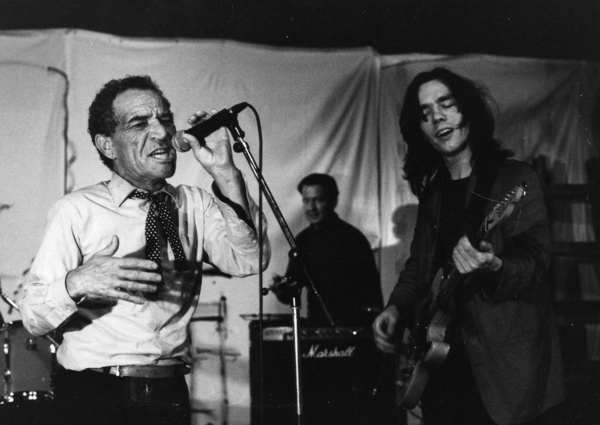
Hamri, Trolley Bus and Frank Rynne by May
Sato
PH: I really want to explore another big theme that
stands out within this interview and the DVD, that of the
presence, music, energy and the cultural symbolism of The
Master Musicians of Joujouka. Theirs is a compelling
role, you both said that they were acting as the glue,
the oil, that lubricated the Show and yet held it
together. A unique property for anyone or thing. What was
the aura like during their mesmerizing shows?
FR:
The volume these men achieved playing just acoustic
instruments was astounding. The musicians played with
furious intent and purpose. They were at once frightening
in their intensity and beguiling through their repetitive
trance inducing beats. Hamri’s presence and his care
for the music and its performance was evident in its wild
authenticity. There was nothing remotely “Real
World” or “World Music” about these
performances. It was easy to understand the phrase
“one thousand year old rock’n’roll
band” which Timothy Leary and Burroughs, in the
early 70s, used to describe the Master Musicians of
Joujouka. It was evident attending the Dublin shows.
However, I endeavored not to be beguiled by the half
baked acid casualty baggage that attached itself to the
Joujouka story when written up by people like Robert
Plamer in the 7Os. Unfortunately that brand of American
hippy rubbish had and has little relevance to the actual
music and lifestyles of the village. Bob Palmer actually
believed that the hill Joujouka sits on was a spaceship.
PH:
A lot of interest surrounds this music, the culture and
the village...
FR:
I have spent years working with and living with the
musicians. When you know them and their families, spend a
lot of time in their individual homes and see their
children grow up over a period of years it gives you a
very different and more accurate knowledge about the
music and the villager`s lives. It is easy to understand
the culture shock that those hippies experienced. For me
Joujouka is not too dissimilar to the area of Co. Clare
in Ireland where my grandfather farmed. The music too is
often quite similar to real Irish folk music. However, as
an acid freak hitting the place in 1971, it may have
appeared rather strange especially with mounds of kif
clouding perceptions of the “real” reality.
PH:
Would you say the cultural history of Joujouka is core to
the music as well as the work of Hamri ?
FR:
Gysin’s paintings especially his Moroccan ones were
heavily influenced by Sufi sects. I have recently seen a
review of a 1956 art show by Hamri which Gysin organized
at the 1001 Nights restaurant. Gysin and Hamri set up
1001 Nights to allow the Master Musicians of Joujouka to
be seen by a wider audience.The reviewer noted that all
of Mohamed Hamri’s works were related to the local
magic of his home village of Joujouka/Jajouka, and the
titles reflected this. I think it will emerge just how
much influence Hamri had on Burroughs and Gysin when
writers and researchers start to look in that direction.
PH:
The scene of The Master Musicians of Joujouka playing
with drummer Brian Downey, from Thin Lizzy, and Hamri,
cajoling and gently teasing more from the musicians is
another real highlight for me, what memories do you have
of that gig ?
FR:
The first time I saw Brian Downey he was in the recording
studio nailing his drum kit to the floor for the first
session of my band The Baby Snakes’ first album,
Sweet Hunger. We finished the drum tracks by nine that
night. Brian Downey is possibly the greatest rock drummer
still with us and ranks with Charlie Watts and John
Bonham easily. To get Brian and The Master Musicians of
Joujouka together was a major musical moment. Brian is as
instinctive as they are and he gelled instantly. His love
of the blues and jazz informed the cool sound of Thin
Lizzy. With Joujouka he provided a masterful and powerful
sequence of rhythms that completely fitted their beats.
That was a remarkable event and improvisation. Ramuncho
Matta, the surrealist painter Roberto Matta’s son,
provided abstract murals on his guitar and The Baby
Snakes guitarist Niall O’Sullivan gave Boujeloud a
hard rock edge. Nothing interfered with the Joujouka
sound, it all just got harder and nastier. Beautiful. The
musicians loved it. They have a great fascination with
drum kits.
PH:
What is the connection to your collaborative cultural
vehicle, The Islamic Diggers?
JA:
The Diggers started life as a sort of anarchist movement.
I edited an underground magazine called The Digger after
I left university and that name derived from the Digger
proto- anarchists in the English Civil War (as opposed to
the contemporaneous Levellers who were proto-socialist),
Emmet Grogan’s Diggers in San Francisco during the
Summer of Love (also anarchist in orientation), and Oscar
Wilde’s university-days Diggers movement which
sought to dig out a road which disappeared into a bog
– in other words a road going nowhere. I had these
political/aesthetic frames of mind in my head around the
time that it became obvious that the leftist Islamic
militancy of the Seventies – that of the PLO,
Gadaffi, and Saddam – was losing ground to the more
Koranic militancy of Osama and his merry men. I related
more to the leftist anti-imperialist rebel Seventies
stance and thought it’d be great if there was an
anarchist Islamic movement, hence the concept of Islamic
Diggers. I’ve been involved with the politics of the
Arab world since I was eighteen. When we started
recording music together, we decided to call ourselves
that name. The militancy continued hand in hand with the
music. The principal manifestations of this activism are
the Cultural Intafadas against the so-called Islamic
heretic, Hakim Bey and against Bachir Attar`s Jajouka.
Hakim Bey is a fake mystic and a fake revolutionary.
Bachir Attar leads a commercial psuedo-Joujouka crossover
act called The Master Musicians of Jajouka Featuring
Bachir Attar. In both of those Cultural Intafadas, we are
reasonably successful and they are both ongoing. As far
as I’m concerned Islamic Diggers is an ongoing
project which can’t be discontinued or prevented. We
included a new track, El Fna, on the Destroy DVD. This
was produced by Paul Schroeder, best known for his
incredible work on the Stone Roses’ second album,
Second Coming. A tragically underestimated album.
PH:
What are you working on now ?
FR:
Musically I am working on a project with Niall
O’Sullivan which brings me back to my roots as a
rock’n’roll singer, performer and songwriter.
We started working together on The Baby Snakes, when we
were 17 years old, and it feels good to get back to that
energy.
JA:
I have my next book, Chelsea Hotel Manhattan, out in
April. I’m very excited about it because this is
something I’ve been working up towards for a few
years. I think it’s my best book – I have total
faith in it. It’s also my most unconventional book
insofar as I’m normally a pretty conservative prose
stylist. Stylistically it bears comparison with my first
novel, Serious Time. I hope Chelsea Hotel Manhattan will
make people laugh and cry. I`d like to work on something
with Chuck Prophet again but Chuck has his own book to do
and I`m sure it`ll be quite a book because Chuck is a
cool customer in every sense of the phrase.
FR:
I have known Chuck Prophet and Dan Stuart since the mid
80s and last met up at the Green On Red show in Amsterdam
last summer which was great. Chuck is one of the greatest
guitarists and that is the direction my music is going
these days. I suppose we are all people who, both, knew
and respected Jeffery Lee Pierce of The Gun Club. Stanley
Booth, Tav Falco the whole Memphis thing around Jim
Dickinson and Alex Chilton also unites us in taste and
connections.
PH:
Those Green on Red shows were good, I liked the
re-scheduled Astoria gig in January last year, the
anti-Iraq War slides shown during the encores were a
powerful statement.....
JA:
I’m also hoping to see a book which I wrote with
Frank called Hashishin out with Sidecartel in the not too
distant future. I had a big success in Ireland late last
year with a book of Irish history and I’m doing a
sort of sequel to that which should be out before the
summer. I have a handful of other projects on the boil
but I tend not to talk too much about future plans
because future plans are just fantasies until you’ve
signed a contract and been given a release date. My main
project is my third novel which is a long way from being
finished. I’m pretty confident that a couple of
filmic projects will come to fruition. I also intend
returning to activism in a pretty serious way. I’ve
been working in front of a computer too long and
I’ve let some people get away with stuff for too
long.
FR:
I am working on a movie project with a French film
director which involves me mixing my training as a
historian with writing an epic movie. I have been working
with The Master Musicians of Joujouka for the last year
for the first time since Hamri's death in 2000. Last year
I was down there six times and brought the musicians to
Porto to play an amazing show at Casa Da Muisica. The CD
Boujeloud which I spent four years working on was
released at the end of 2006 and is getting a great
reception. It contains all the music from the Boujeloud
ritual, The Pipes of Pan. The musicians had a good year
in 2006 and they are keen to promote the real Sufi music
of Joujouka globally. They were visited by Billy Corgan
in March when he was researching the new Smashing
Pumpkins album. I have an interview with Ulick O`Conner
and a piece on Herbert Huncke in Joe Ambrose's
forthcoming Chelsea Hotel book and the book on Hassan I
Sabbah, Hashishin that myself and Joe wrote will be out
this year. I am also currently working on a detailed
study of the Irish revolutionary movement the Irish
Republican Brotherhood or Fenian Brotherhood and their
involvement in the Irish Land War 1879-83.

And
here endeth the interview. Many issues have been covered
and opinions given. I hope this has enabled the context
as well as the content of the Destroy All Rational
Thought DVD to be examined and discussed, as the Here To
Go Show has proved to be a unique and powerful event.
The
controversy surrounding of The Master Musicians of
Joujouka /Jajouka continues. Notable is the sporadic
popularity of a “Jajouka” band, led by Bachir
Attar, whose father was a Master Musician of Joujouka.
Attar`s musicians have toured and enlisted the support of
the likes of Talvin Singh, whose own music adorns the
coffee tables of many around the world. Of particular
interest to me in this is the talismanic significance of
the position of a `celebrity in production and promotion`
of Bachir Attar`s Jajouka band. This is of considerable
value, indeed heavy with currency, suggesting to the
consumer cultural and authentic worthiness. Adding a
celebrity producer enhances an aura of authenticity,
according to Philip Schuyler`s interesting essay on
Moroccan Music and Euro-American Imagination, to the
industry`product`, ie, in this case, to Attar and Singh`s
Jajouka CD. It follows that one can be lead to believe
without said `celebrity`, the product is therefore
`lacking`(in the consumer`s eyes) in the marketplace,
i.e. the World Music Section in the supermarket, or, the
full page advert in Mondomix, for example. Schulyer
proposes that the addition of `celebrity` is one of a
group of signifier`s within the Music industry (1). The
term, World Music, being a Music industry created niche
market. These signifiers are included, contrived or
attached to instill the attributes of authenticity,
spirituality and originality in the product, making it an
attractive purchase and legitimising consumption of the
product. The extent to which the village and the people
of Joujouka fully feel the impact of sales, in the
bettering of their lives and in preserving their cultural
heritage, is difficult to establish. That is a
fascinating piece of work I intend to research in the
future.
Many
thanks to Joe Ambrose and Frank Rynne.
Note(1). Taken from Chapter 6, Moroccan Music and Euro-American Imagination by Philip Schuyler, in Mass Mediations - New Approaches to Popular Culture in the Middle East and Beyond, edited by Walter Armburst, University of California Press, 2000
Joe`s
book, Chelsea Hotel Manhattan is scheduled for an April
release on Headpress and the release of Hashishin, co
written by Joe and Frank, is to be released on Sidecartel
later this year. Frank Rynne is hard at work on a movie
project and songwriting for a new album.
Destroy
All Rational Thought is available on DVD through all
scrupulous online media outlets as well as over the
counter at outlets at your discretion.
MVD
distribute in the USA. Screenedge elsewhere.
Paul
H.CopywriteOn .
The Brink... of greatness, disaster, Survival
http://www.brink.com/bio/Paul+H
outsideleft - rock n` roll writing about pop culture
matters
http://www.outsideleft.com/about.php?winfoID=31
TruculentEnigma
http://blog.myspace.com/truculentenigma
.
